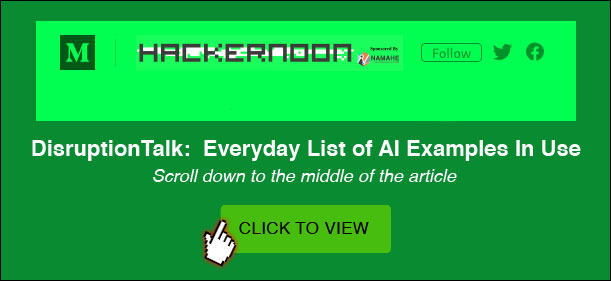Chapter 6 – Artificial Intelligence (AI)
by Steve Covello - Granite State College (USNH); Concord; and NH
“The development of full artificial intelligence could spell the end of the human race.” – Stephen Hawking (BBC News, “Stephen Hawking warns artificial intelligence could end mankind“, 2014).
“[AI is] the biggest risk that we face as a civilization.” – Elon Musk, Tesla CEO (Wall Street Journal, “Elon Musk Lays Out Worst-Case Scenario for AI Threat“, 2017).
Overview
 It seems inevitable that if computers can be programmed to “think” like humans, they would be employed to do the things humans do, for humans. After all, wouldn’t it be nice if we all had our own personal assistant working 24/7 to answer questions and do tasks on our behalf?
It seems inevitable that if computers can be programmed to “think” like humans, they would be employed to do the things humans do, for humans. After all, wouldn’t it be nice if we all had our own personal assistant working 24/7 to answer questions and do tasks on our behalf?
In the past few years, a convergence of advanced technologies, development standards, and interconnectivity has made it possible for computers to recognize patterns in speech and data to interact in remarkably human-like ways.
In this chapter, we will review the implications of artificial intelligence (AI) in the human environment.
Key Terms
Artificial Intelligence (AI) – “Artificial intelligence is the design, implementation, and use of programs, machines, and systems that exhibit human intelligence, with its most important activities being knowledge representation, reasoning, and learning.” (Whitson, G. P., 2013).
Artificial General Intelligence (AGI) – “…[I]s when a computer program can perform any intellectual task that a human could.” (Astute Solutions). AGI, also referred to as “strong AI”, would have the ability to acquire new knowledge and skill on its own, learn from examples, and understand the context of a situation. Voss’ article (2017) provides a bullet list of eight points that describes the capabilities of an AGI algorithm. It is important to note that practical AGI machines do not yet exist.
Artificial Narrow Intelligence (ANI) – “[R]efers to a computer’s ability to perform a single task extremely well, such as crawling a webpage or playing chess.” (Astute Solutions). Examples include computer vision (which is how Facebook is able to identify a person in a photo), Google Translate, and a commercial website offering you purchase suggestions based on your prior purchases. ANI is considered to be a “weak AI” because it can only do what it is designed to do and nothing more (Dickson, 2017), and its capabilities are limited to the programmer’s design. In other words, it cannot “self-learn” (Voss, 2017).
Artificial Super Intelligence (ASI) – “[a]n AI [entity] that surpasses human intellect.” (Whitson, G. P., 2013). As with AGI, this level of AI does not yet exist as a practical technology
Bot – A communication application designed to act as a virtual assistant using humanlike communication. Some use text alone, some use synthesized speech. Popular examples include: Alexa, Amazon Echo, Siri, Cortana, and Google Duplex. A Chat bot is a bot that interacts through a text based chat service.
Deep Learning – A method of producing a set of patterns by placing input data through multiple layers of computer processors. The goal is to process data in a way that mimics neural processing in the human brain to develop a “smarter” algorithms (Dickson, 2017). An example would include an algorithm that is able to detect cancer from scanning an X-ray – a process called “computer-aided detection”. A definitive, in-depth description of Deep Learning’s capabilities and limitations is in Marcus’ (2018) article, “Deep Learning: A Critical Appraisal“.
Machine Learning – A process for programming a machine to learn from analysis of examples. For example, a computing device can be programmed to learn what a cat looks like by providing it millions of pictures of cats so that patterns of similarity can be collected and then used as a basis for matching against an example (Dickson, 2018).
Natural Language Processing: A machine learning method for interpreting language for the purpose of enabling computing systems to understand human communication. Read more at the Educause Learning Initiative’s (ELI) article “7 Things You Should Know About Natural Language Processing“.
Turing Test – “…[A] test of a machine’s ability to exhibit intelligent behavior equivalent to, or indistinguishable from, that of a human.” (Wikipedia). The roots of this expression are in the 1951 experiment conducted by Alan Turing to test human perception of machine intelligence. Since then, the expression “Does it pass the Turing Test?” has become a refrain for every demonstration of computer intelligence.
What should you be focusing on?
Your objectives in this module are:
- Identify the different forms of AI.
- Identify how various AI technologies are currently used in the real world.
- Appraise the potential ways AGI/ASI might be useful.
- Evaluate the benefits and risks of implementing AI.
Readings & Media
Thematic narrative in this chapter
In the following readings and media, the authors will present the following themes:
- AI has tremendous potential to assist people in everyday life.
- The use of AI poses extraordinary risks.
- AI is pretty cool!
- AI will kill us all. Or maybe not.
Required Examples of AI technologies
Google Duplex bot: Here is a demonstration of Google Duplex, an ANI, being used to make phone calls to schedule tasks. If you go to the video’s listing in YouTube (by clicking on the YouTube icon on the lower right of the video player) be sure to check out the creative comments from people who are already imagining what else this kind of bot will be useful for.
https://youtube.com/watch?v=D5VN56jQMWM%3Frel%3D0
What is DeepMind and why does it matter?
DeepMind is an ongoing experimental AGI project begun in 2010 by Dr. Demis Hassabis in London, England. In 2014, the company was acquired by Alphabet, the parent company of Google. DeepMind’s credo is “Solve intelligence. Use it to make the world a better place“.
In practical terms, the DeepMind team sees AGI in terms of “…increasing [humans’] capacity to understand the mysteries of the universe and to tackle some of our most pressing real-world challenges. From climate change to the need for radically improved healthcare, too many problems suffer from painfully slow progress, their complexity overwhelming our ability to find solutions. With AI as a multiplier for human ingenuity, those solutions will come into reach.”
DeepMind’s AlphaGo AGI defeats the world’s great Go player: DeepMind is an experimental AGI system. The following video is a movie trailer for a documentary about how DeepMind was programmed to learn the rules of Go, and then learn all on its own to improve its ability to play. Ultimately, it defeated the world’s greatest Go player in a way that showed how it is possible for AGI to learn more than 3,000 years of human experience.
DeepMind teaches itself how to walk: In the video below, we see a demonstration of DeepMind creating a manner of humanoid walking without it having been given any prior information on what walking is or how humans actually walk. While the results may be amusing, it demonstrates how a “naive” AGI system can discover creative alternative possibilities for solving problems that a human might not have considered.
Demonstration of Sophia, a robot with AI programming: The following two brief videos demonstrate an initial foray into AI enabled robotics. Details include speculation about the role of AI robots among human society. It can be a bit clumsy at times, but it is still a fascinating (frightening?) initial encounter.
Required Article: Explore the range of AI applications in this comprehensive list:
Required Infographic: What is “Mathwashing”?:
The “What is Mathwashing?” website is designed to appear like a scrolling infographic. It explains how the mathematics at the core of AI can be biased and how the presumption of “mathematical truth” can cause algorithmic bias to go unchecked. The value of this infographic is in the call for us to demand transparency in the algorithms that have a direct impact on the options available to us, as individuals, because of AI tools that inform decisions. The conclusion includes references to articles and publications that report on this issue.
Required Article: Henry Kissinger’s take on AI
The Atlantic: “How the Enlightenment Ends: Philosophically, intellectually—in every way—human society is unprepared for the rise of artificial intelligence” by Henry A. Kissinger. Kissinger places the presence of AI into a contemporary context while citing milestones along the way. Keep in mind that this is commentary – not peer reviewed research. Kissinger does not support his cause/effect claims with empirical evidence nor substantiates the outcome if we adopt it.
However, his position as global public figure for over a half-century places him in a position to observe AI from a useful global perspective.
Optional: Supplemental resources that are relevant to AI
The Guardian: “Weaponised AI is coming. Are algorithmic forever wars our future?” – Weaponized AI in military operations to determine who are suitable targets for killing.
AI Weirdness: Janelle Shane writes about “…the intersection between art and science.” She has published the AI Weirdness blog that describes the results of “…training neural networks to write unintentional humor as they struggle to imitate human datasets.” Check out the results of an AI bot producing the names of “high tech pies that sound really old” and some indescribable Halloween costume ideas. If you are truly courageous, check out the artificially generated photo images produced by the BigGAN system. Some are beautiful; some cannot be unseen.
The New Yorker: “How Frightened Should We Be of A.I.?” by Tad Friend (May 14, 2018). This well-cited article introduces some speculative questions about the consequences of AGI development. There are many references to popular media that help explain the issues. The article’s style is very accessible for a non-technical audience.
Educause – 7 Things to Know…: Natural Language Processing: “Natural language processing combines the power of artificial intelligence with linguistics to process and analyze language-based data.” From the Educause Learning Initiative.
Princeton research: Dialogues on AI and Ethics. This collection of fictional case studies is designed for use by educators to think about the ethical ramifications of AI in healthcare, sound identification, and education.
A collection of bot apps: Chatbottle.co is an aggregator for bot applications you can use through your Facebook, Skype, Slack, Telegram, and Kik accounts. Click on some and play around in your Facebook or Skype account.
Chat with some bots using your Facebook Messenger account:
Try out Swelly, Foxsy, Poncho, DoctorBOT, Wall Street Journal or Zup.
Create you own bot: “Build a chatbot for your business in minutes!” on botwiz.ai.
For developer geeks: “Anatomy of an AI System” shows a schematic model of how an AI system is developed.
The Atlantic: “Can Artificial Intelligence Predict Religious Violence?“. AI is used to quantify the conditions of religious conflict and predict when the conditions of a situation might lead to violence.
References
Dickson, B. (2017, May 12). What is Narrow, General and Super Artificial Intelligence. Retrieved June 9, 2018 from https://bdtechtalks.com/2017/05/12/what-is-narrow-general-and-super-artificial-intelligence/
Dickson, B. (2018, February 27). The limits and challenges of deep learning. Retrieved June 9, 2018 from https://bdtechtalks.com/2018/02/27/limits-challenges-deep-learning-gary-marcus/
Dickson, B. (2018, March 16). What is machine learning? Retrieved June 9, 2018 from https://bdtechtalks.com/2017/08/28/artificial-intelligence-machine-learning-deep-learning/
Marcus, G. (2018). Deep Learning: A Critical Appraisal. arXiv preprint arXiv:1801.00631. Retrieved June 9, 2018 from https://arxiv.org/abs/1801.00631
Voss, P. (2017, October 3). From Narrow to General AI and from External to Internal Intelligence. Retrieved June 9, 2018 from https://medium.com/intuitionmachine/from-narrow-to-general-ai-e21b568155b9
Whitson, G. P. (2013). Artificial intelligence. Salem Press Encyclopedia Of Science,
Photo Credit: Photo of Elsa Lanchester and Boris Karloff from the 1935 film The Bride of Frankenstein via Wikimedia Commons CC0.


